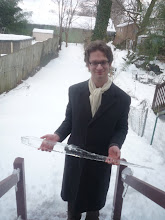In my class on Japanese women writers, we are now into the Edo period. The Edo period, which lasted from 1600 to 1868, was the worst time to be a woman in Japan maybe ever. First of all, education was completely segregated. This is not uniquely bad by itself, but in this case the main textbook for women, Onna Daigaku, contained such gems as ‘to you your husband should be as Heaven itself; you must love and serve him with fear and trembling, lest you call down upon yourself celestial castigation’. The dominant political ideology was a bizarre form of Confucianism in which women were literally perceived as walking wombs, and one of the government’s slogans (the ‘yes we can!’ of its day, almost) was ‘danson johi’, which means ‘revere men; despise women’.
However, in this horrible, horrible environment, there were a few really awesome ladies who survived and even thrived to produce really amazing literature. I’m thinking here particularly of three women (those who we’ve covered extensively in my class), all of whom I really admire the Hell out of for putting up with this bullshit, both in their lifetimes and after their deaths (no women ever appear in anthologies of Edo literature, despite the output of these three and others).
- Arii Shokyuu (1714-1781). Satirical poet and sometime travel writer. She was a third- or fourth-generation member of Basho’s poetry school and is known mainly for inflicting some of the worst (by which I mean BEST) puns on the Japanese language in the history of its literary tradition. May or may not have been an actual nun; certainly lived like one in a lot of ways. Only female Edo writer to attain some measure of popular acclaim and ‘respectability’ (as a writer, at least). Author of Record of the Autumn Wind. Compare: Mark Twain, Bill Bryson, Jan Morris.
- Tadano Makuzu (1763-1825). Political philosopher, in her own cultural context considered extremely traditionalist and conservative, but in a broader context also advocated such things as imprisoning large-scale merchants for being parasitic middlemen who oppressed the workers. Religiously traditionalist and nationalistic; positioned herself as opposed to politically conventional and economic rationalism (as it was perceived at the time). Had a friendship with Takizawa Bakin that went bad when he refused to apologise for being a ‘simple fool’. Author of Solitary Thoughts. Compare: Dorothy Day, Christopher Lasch, Franziska von Karma.
- Ema Saiko (1787-1861). Refined and highly educated and formalist poet, with command of Japanese, Chinese, and possibly Dutch. A dyed-in-the-wool hikkikomori and total daddy’s girl; her father, by all accounts, was awesome enough to completely deserve it. She is now mainly known (unfairly so) for getting NTR’ed by Rai San’yo. Really liked The Tale of Genji kind of a lot. Wrote poems about having to refuse her little sister alcohol. Author of Breeze through Bamboo. Compare: Emily Dickinson, Elizabeth Bishop, Christina Rossetti.
I really like and admire all three of these ladies but Arii Shokyuu is probably my favourite. Here are two of her groaningly awful (by which I mean AWESOME) pun-couplets:
Why is my hat frazzled now…?
—The autumn wind. (TL: this is a pun in Japanese)
So I turn back to look once more,
For I am a woman, at Mt Kagami. (TL: kagami means mirror)
And here is a slightly longer poem by either her or one of her compadres, it’s not quite clear:
A robe of mist
Soaked at the hem
Princess Saho
With the coming of spring
Stands pissing.
So, pretty much, when I grow up, I want to be a coolface-tier haikai writer and travelogue author just like her.

No comments:
Post a Comment